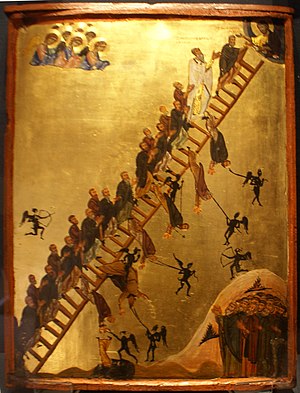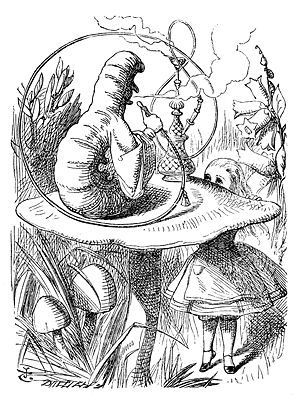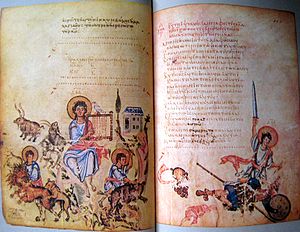I owe most of the following either to John Ashton in his second edition of Understanding the Fourth Gospel or to someone he cites in there (unfortunately cannot recall which):
Firstly, the original Aramaic expression for what is generally today translated as Son of Man really means nothing more than a man-like figure or one like a man. Secondly, that original Aramaic meaning is by Christian times irrelevant since by the time of the Christian writings and Jewish apocalyptic writings of the same era, it had come to mean what it is translated as today: Son of Man.
Before the Son of Man appears
Prior to the entrance of Daniel’s Son of Man is the well-know fourth beast (the Syrian/Seleucid empire of Antiochus Epiphanes — not Rome!)
Daniel 7:19-21, 23-25
Then I would know the truth of the fourth beast, which was diverse from all the others, exceeding dreadful, whose teeth were of iron, and his nails of brass; which devoured, brake in pieces, and stamped the residue with his feet; . . . that horn that had eyes, and a mouth that spake very great things, whose look was more stout than his fellows. I beheld, and the same horn made war with the saints, and prevailed against them; . . . .
Thus he said, The fourth beast shall be the fourth kingdom upon earth, which shall be diverse from all kingdoms, and shall devour the whole earth, and shall tread it down, and break it in pieces. . . . And he shall speak great words against the most High, and shall wear out [persecute] the saints of the most High. . . and they shall be given into his hand . . . .
The fourth beast was terrifying particularly for making war against the saints, the people of God, and martyring them.
A series of beast-like creatures had appeared. The first was “like a lion”. This eventually became “like a man”. (Dan. 7:4). The next was “like a bear”, and the third “like a leopard”. Presumably these could, technically, have been translated originally as “Son of Lion, Son of Bear, Son of Leopard, just as the successor to the fourth beast was translated “Son of Man”. I say technically, and do not suggest this translation by any means. But this makes a significant point about the original meaning of the Aramaic “man-like figure”.
If the four beasts are 4 kingdoms (Dan. 7:17), is the Son of Man any different?
The original meaning of the Son of Man
When the Most High brings low the fourth beast, Daniel is told that at that time,
the kingdom and dominion and the greatness of the kingdoms under the whole heaven shall be given to the people, the saints of the Most High . . . . (Daniel 7:27)
This verse is the angelic interpretation of the vision Daniel had seen of the one “like a Man” replacing the fourth beast:
I watched till the beast was slain, and its body destroyed and given to the burning flame . . . . I was watching in the night visions, and behold, one like the Son of Man coming with the clouds of heaven! He came to the Ancient of Days, and they brought him near before him, then to him was given dominion and glory and a kingdom . . . . (Daniel 7: 11-13)
It is thus not difficult to interpret the original meaning of the Son of Man as a symbolic reference to the Jews or the saints once liberated from the power of the Syrian empire, particularly from Antiochus Epiphanes.
But there’s (almost certainly) more
Place this interpretation beside that other Second Temple exegesis about the offering of Isaac at the time of the Maccabean martyrdoms: see Jesus displaces Isaac and the full set of my notes from Levenson at this archive.
From Levenson, we know we have are clear evidence of speculation about a resurrection of Isaac from his sacrifice among certain Jewish circles. We can also see in the original meaning of the Son of Man in Daniel that this figure could well represent the saints rising victorious to claim the kingdom after having suffered martyrdom at the hands of the fourth beast.
As the man-like figure became reinterpreted to refer to a singular heavenly being, one like the Son of Man, do not early Christian beliefs that the Son of Man was to be delivered up and crucified and rise again suggest the strong possibility that the original interpretation of this figure in Daniel, as one representing the persecuted yet ultimately victorious saints, also carried over with the personification of the term?
And not only the Christians
As John Ashton remarks, it is really difficult to know if the Son of Man figure in Daniel is meant to be seen as an evanescent dream like waif figure, or a real angelic being. Are the beast-like creatures really mere visions or is Daniel watching heavenly creatures act out what is to happen on earth?
If the latter, then it seems that the Son of Man was seen as a literal spiritual being who was to be identified with Christ.
But this sort of speculation and evolution of interpretations of Daniel was part and parcel of strands of Jewish thinking generally at the turn of the era. Christians had a complex Jewish heritage to draw on for their theological creations.
This is topic of the next post, Jesus in the Gospel of John — and Jewish Apocalyptic
Like this:
Like Loading...

 In his
In his 

